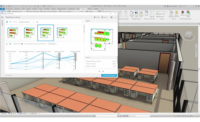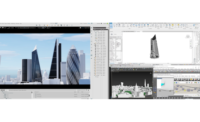Construction Technology
STV Partners With Generative Design Tech Firm for Wastewater Treatment Plants

A 3D design for a PFAS water treatment facility, generated by Transcend.
Image courtesy Transcend
Based on planned and anticipated market growth, global consultant STV has formed a strategic partnership with Transcend, a maker of generative design tools for wastewater treatment plants. The tech firm produces full 3D models for treatment facilities for larger project owners to incorporate into their capital planning and for design teams to adapt to changing client needs.
“Transcend brings lot of value in our ability to consider a universe of options, narrow those down, and ultimately make final select with the owner, compress that timeline, and create more efficiencies,” says Chris Haney, STV water operating group president.
STV anticipates more work not just in wastewater treatment plant upgrades and expansions but also in meeting requirements of federal regulations enacted in recent years, such as treatment mandates for PFAS chemicals. “PFAS regulations came in last year, which will drive quite a bit of work over next several years and decades,” adds Haney, noting that there are not enough dollars available for all projects needed, and owners will need to maximize funding they have secured.
Transcend was founded in 2019, originally as an outgrowth of an EPC firm that was looking to develop new design concepts in wastewater treatment. The system is based on parametric and generative design principles, as opposed to the newer kind of machine learning and large-language model-driven artificial intelligence-type systems seen in ChatGPT and similar AI systems.
That is an important distinction, says Transcend Chief Customer Officer Adam Tank, since his company's AI system is not capable of the kinds of “hallucinations” and sporadically unreliable output some other AI tools can generate.
“There’s a lot of talk going around about generative AI [like ChatGPT] versus generative design, and we are the latter,” he explains. “I would never trust a generative AI model to create a physical structure that needs to be based on engineering principles and decisions, since we can't track the decisions that the model made in creating the final output.”
Instead, Transcend works from basic engineering principles and rules in its generative output and enables the user to check its work. The goal is not to eliminate the designer but to speed up its ability to iterate different designs to client needs, says Tank.
“Every single decision the software makes can be traced back to a textbook rule of thumb,” he explains. “So if you ask 'why is there this number of blowers or membranes', it can show you in an engineering textbook the page where the formula it used is located.”
Transcend’s models are exported in widely used formats, with its piping designs editable in AutoCAD and an option to export a RVT file for direct use in Revit.
The tech firm's system works through several stages. It starts off a base level of water quality and effluent processing goals and available treatment options. Then it takes into account site and civil data, physical constraints of the plant location and how those factors would impact standard or nonstandard facility designs. This is useful for greenfield projects and also for optimizing existing plants, says Tank.
“So we can pull up a geolocated map and mark up the buildings, give the software parameters for a clarifier, how deep the foundations are and how thick the walls are—and the software can make smart decisions. You can also do this with a facility built 20 to 30 years ago where you have lost the as-builts and it is operating differently than designed.”
This approach can lead to even wider discussions with clients, says Tank. “Once you see what’s working as designed versus as operating, we can ask if there is room to improve, or realize we are maxed out and we need to switch into the CapEx side [of the discussion].”
A Useful Tool in a Demanding Sector
For STV, this kind of rapid automation can help meet rising demand for water project work, says Haney. “It’s not to say we can push a button and have a state-of-the-art wastewater plant delivered to us, but there are parts and pieces early on in the project that can be significantly automated and streamlined.”
But the deliverable models are not the real value of Transcend’s tools, explains Haney. “We are now at a place to have much broader conversations with clients on selecting the right approach for a particular project,” in in the design phase but also much earlier, he says. “It’s very beneficial on the front-end, when the client only has an idea of what is wanted. With these scenarios we can create [in Transcend] conversations that can commence on bigger, broader ideas.”
STV does not plan to replace human engineers' input on projects, but Transcend is extending their capabilities, says Tank, who says the tech company also has its own slate of licensed wastewater and process engineers shaping the generative design system.
“We want to build [designs] that are tried and true, but if there is an option to try something different in Transcend it’s just like checking a box,” he says. “Why not try a membrane plant, or granular activated sludge, or look at aftertreatment? When engineers can look at more options, they can be more proactive.”
For every engineer used to tweaking a few settings in simulation software and calling it a day, Tank says Transcend has found there are plenty of others who want to try out new ideas. “We find there are wicked-smart engineers looking at traditional treatment, but also have a harebrained idea they think will work. Yet traditional engineering has no time or money to try it, so they give the client only what is wanted. 'Could we repurpose these tanks and change them around?' Let’s run a scenario in Transcend and create the data to show it's a valid option to be considered,” he says.
All of this is within the engineer's existing job, but Transdend allows for options that traditionally would not be worth the time or money to explore. Users "are not trying to massage the data to get answers they want, but trying out ideas they don’t have time to simulate to show a wild idea can work," adds Tank.
For some growing markets, thinking outside the box may be more of a necessity than ever, Haney says. “Texas already has challenges meeting its water demands, and state water needs are valued at $150 billion,” he says, adding that high-demand facilities such as data centers will only tax water infrastructure further. “We see Transcend as a partner and an opportunity to address these issues,” Haney contends.





